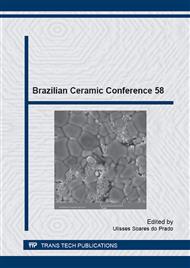p.187
p.193
p.199
p.205
p.213
p.218
p.225
p.231
p.239
Mechanical and Microestructural Characterization of AL2O3 - ZrO2 Ceramic Composite Reinforced with Rare Earth Oxides (Y2O3) for Inert Coating of Storage and Transport Systems of Crude Petroleum
Abstract:
The advancement of the oil sector has generated the need for the use of materials resistant to aggressive environments to oil. Although ceramics have high melting point and high hardness is, on the other hand, more fragile and less tough, which can cause damage to the metal structure. The Al2O3 based ceramics reinforced with rare earth oxide can improve tenaciousness and makes the ceramic material more resistent. This article aims to present the production of composite Al2O3 - Y2O3 stabilized ZrO2 by uniaxial pressing, following sintering (1200-1350 °C). Structural and microstructural characterizations as XRD (X-Ray Diffraction) and SEM (Scanning Electron Microscopy) and mechanical tests as Vickers hardness, % absorption and % linear shrinkage were conducted to evaluate the feasibility of using the composite and ceramic coating for storage and transportation of oil tanks. The results indicate that the proportions of 5%, 10% and 30% ZrO2 make it suitable as a good composite suitable coating.
Info:
Periodical:
Pages:
213-217
Citation:
Online since:
June 2015
Price:
Сopyright:
© 2015 Trans Tech Publications Ltd. All Rights Reserved
Share:
Citation:


